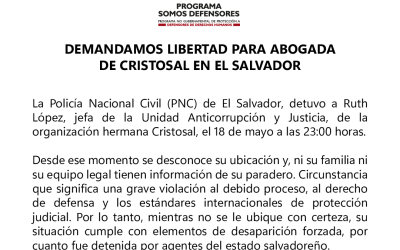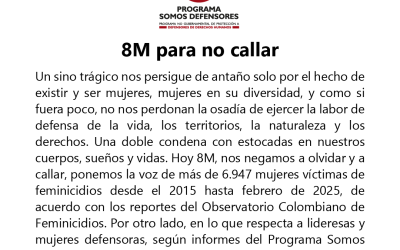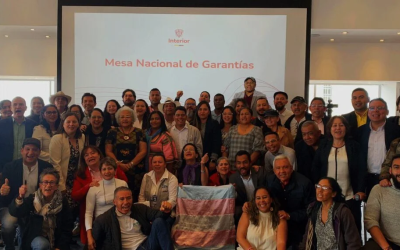Colombia could well be seen as a piece of music, a composition with many tones, but in essence melancholic and full of uncertainty. The music never stops playing, but there is almost never a change in the melody. The year 2022 was a particular year for the country, because finally, after years of listening to the same tones, a new piece of music was heard, it was an interlude, an intersection towards a new composition that seemed different and more hopeful.
The arrival of a new government in August became a possibility of transformation for the country, so that communities and people who for decades have been on the margins could finally be considered and an opportunity to make way for the transformation of security conditions in the regions so that the civilian population and, particularly, human rights defenders and social leaders could carry out their work with all the guarantees.
That is why our annual report 2022 is entitled interlude, which is the state in which we consider we are at present, a moment of change between the usual melody and a new piece, what will the new work sound like? We still don’t know for sure, but we cling to the hope that it may be different, although so far, we see a complex reality of the strengthening of illegal armed groups, the continuity of disputes for the control of territory and the persistence of selective violence.
During 2022, human rights defenders and social leaders were victims of 840 aggressions, a fairly high record that evidences the risks faced by those who defend human rights in the country and the repertoire of forms of violence to which they are exposed in this context. In this period the murder of 197 defenders was verified, which means an increase of 42% compared to the year 2021, a number that almost equals the figure of 2020 when 199 murders were recorded, the highest number of defenders killed in one year confirmed by our information system.
In this way, this report aims to show the melody of political transition, on the one hand, there is hope for the possibilities of achieving guarantees for the lives of communities and human rights defenders and, on the other hand, the reality of change that is slow, full of stumbles and that is taking place in a highly conflictive context.
These issues are addressed in three chapters. The first chapter, entitled Change of partiture, highlights aspects that are part of the new political bet, especially two of the major issues that have been proposed by the new government. On the one hand, the Total Peace Law, an ambitious initiative that has made progress but not without stumbles and difficulties; on the other hand, the emergency plan for the protection of human rights defenders, social leaders and peace signatories, which includes very important elements for the construction of public policies of guarantees, which for its formulation had the active participation of human rights organizations, among other important aspects, but which at the same time has shortcomings in its implementation. In addition, it should be noted that these initiatives occur in the midst of a complex context of reconfiguration of the armed conflict and marked by 9 territorial conflict hotspots, as Indepaz points out.
The second chapter, entitled Adagio, shows that despite the changes that the government is trying to implement, this dynamic has not been transferred to the control and investigation bodies, which continue to be in debt with human rights defenders and social leaders. On the one hand, the Attorney General’s Office, which does not present sufficient progress in the investigation of cases of human rights defenders’ murders and other types of aggressions such as threats, causing the persistence of impunity. It is also noted that other bodies, such as the Attorney General’s Office, also continue to be indebted to the situation and if there are results, it is impossible to demonstrate them due to their limited responses to the rights of petition. Finally, it is noted with concern the high number of Early Warnings issued in 2022 by the Ombudsman’s Office and, despite this, the consummation of the risks manifested in the deficient state response. The third chapter, entitled Dissonance, presents an analysis of the cases of aggressions documented and confirmed during 2022 by our Information System on Aggressions against Human Rights Defenders in Colombia -SIADDHH-. In this way, a trend of persistence of selective violence in the country is exposed, with the confirmation of 840 aggressions of different types, which shows the diversity of violent acts faced by social leaders and human rights defenders. It is recognized that all forms of violence are serious and generate affectations to the lives of those who defend rights, however, a particular concern is highlighted about lethal aggressions such as murder, due to the significant increase in this type of violent act of which 197 cases were confirmed in 2022, which means an increase of 42% in relation to the previous year. The fact that this type of cases continues to increase is of concern because dozens of people continue to be murdered each year and the social processes of which they were part are seriously affected without effective measures to curb this situation. It is also considered that the ¿ territorial factor is a determining element in the behavior of violence, and for this reason this chapter focuses on the territories with the highest concentration of murders, with the acknowledgement that in order to understand the aggressions against defenders it is essential to observe the geography of violence.
In conclusion, this report is an invitation to continue reflecting and calling for action on the behavior of selective violence against human rights defenders in Colombia, understanding that the aggressions committed against them have a structural and multidimensional origin, in addition to the fact that they depend on the state response or, in the case of Colombia, the precarious state response. We also want to recognize that behind every figure in this report there is a human rights defender and that the violence they receive has an impact on multiple levels, as it also affects their families, organizations and communities, destroys processes and affectsmus as a society by seriously wounding democracy.
Finally, we would like to take this opportunity to thank all the organizations and individuals who are always present in the process of the Somos Defensores Program to produce the periodic publications. Our sincere thanks to all those organizations andmindividuals who provided us with inputs for the preparation of this report: Early Warning System -SAT- of the Ombudsman’s Office; Office in Colombia of the United Nations High Commissioner for Human Rights; Association of Indigenous Councils of Northern Cauca; Development and Peace Foundation -FUNDEPAZ; Permanent Committee for the Defense of Human Rights Risaralda; Yariguíes Corporation; Territories for a Dignified Life; ORIPAP; CINEP; Sumapaz Foundation; Joel Sierra Human Rights Foundation; Campaign for Life, Integrity, Dignity and Autonomy of Social and Popular Organizations Soacha; Corporation for Education and Citizen Self-management -CEAC-; Colombia Diversa; Sisma Mujer and the Cordoba Controversial Social Foundation -CORDOBERXIA-. Thank you for your trust and your conviction in the importance of the work carried out from our information system.
También queremos agradecer a las agencias de cooperación y organizaciones que nos apoyan en nuestro trabajo diario y nos animan a continuar con él, como Bread for the World, Misereor, Global Witness, Amnistía Internacional y Front Line Defenders, y en especial la Royal Norwegian Embajada en Colombia y Diakonia Suecia, por su constante apoyo ha impulsado el trabajo del Programa Somos Defensores y la elaboración de publicaciones periódicas para visibilizar la situación de riesgo que enfrentan las personas defensoras de derechos humanos y líderes sociales en Colombia.





